The performance of an idealized spherical sampler facing both vertically upwards and downwards in calm air is studied numerically. To describe the air flow around the sampler, both potential and viscous flow models have been adopted. The equations of particle motion are then solved to calculate the aspiration efficiency. The dependence of the aspiration efficiency upon the various parameters of importance in calm air sampling are investigated and compared where possible with the experimental work of Su and Vincent (Citation2003, Citation2004a, Citationb).
It is found that in the case of upwards sampling the bluntness of the sampler only has a significant effect upon aspiration for large sampling velocities, values that would not generally be physically realistic. In the case of downwards sampling an important non-dimensional quantity, B 2 R C , is identified, where B represents the sampler bluntness and R C represents the gravitational effects. This quantity determines the physical conditions for which aspiration will not occur and also the limiting values of the aspiration efficiency when aspiration does occur. In the case of low sampling velocities a difference is noted between experimental and numerical results for aspiration efficiency raising the need for more experimental data in this area. For both upwards and downwards sampling the semi-empirical models of CitationSu and Vincent (2004b) have been modified to account for the information gained from the study. This is particularly important in the downwards sampling case where the modified model is found to agree particularly well with the results obtained.
INTRODUCTION
Aerosol samplers are widely used in present-day environmental and health studies to measure the aerosol concentration in the air. However, due to the inertia of the particles moving in the air flow in the vicinity of the sampler, the measured aerosol concentration can differ from the real concentration. The distortion in the value of the concentration can be expressed by the aspiration efficiency, which is defined as the ratio of the measured and real aerosol concentrations. For historical reasons, attention has focussed on samplers operating in moving air where the wind speeds are such that the predominant force bringing particles into the vicinity of the sampler is the drag due to the air motion. Due to the numerous experimental and theoretical studies on this topic the performance of aerosol samplers in moving air is reasonably well understood. A review of much of this earlier work is given by CitationVincent (1989). However, the performance of samplers operating in calm, or near calm air, is less well understood and in the past has received less attention. This is a topic of importance as indoor air flows are usually characterized by very small velocities, see, Berry and Froude (1989) and CitationBaldwin and Maynard (1998). For such conditions the model of calm air sampling is an accurate description of indoor aerosol sampling conditions.
Past experimental and theoretical studies of the aspiration efficiency for samplers operating in calm air include CitationDavies and Peetz (1954), Kaslow and Emrich (1973, 1974), CitationYoshida et al. (1978), CitationBelyaev and Kustov (1980), CitationAgarwal and Liu (1980), CitationGrinshpun et al. (1989), CitationChung and Dunn-Rankin (1993) and CitationDunnett (2002). Although these earlier works have increased our understanding of how samplers perform when operating in calm air conditions, our knowledge is far from complete. In particular the influence of the sampler body upon performance is not fully understood. Hence, in this work, a study is made of the performance of a blunt sampler operating in calm air. Recently experimental studies were undertaken into the sampling performance of thin-walled, and some simple blunt, samplers by Su and Vincent (Citation2002, Citation2003, Citation2004a, Citation2004b). Such studies are invaluable in furthering our understanding on this topic as experimental data with which to validate numerical models is lacking due to the difficulties in obtaining it. In the case of the thin-walled samplers some numerical work was also undertaken by CitationSu and Vincent (2004a). The experimental method, known as the direct method, involved the direct visual observation of the limiting particle trajectories and hence the results obtained do not include errors due to particle bounce or blow off from the external surface of the sampler. In the work of Su and Vincent, the experimental data is displayed in tabular form making it available to compare with numerical models. The experimental data for both the blunt and thin-walled samplers was used by CitationSu and Vincent (2004b), to develop semi-empirical formula to describe the aspiration efficiency of samplers facing upwards, downwards and horizontally.
In this paper the results of numerical studies of the performance of a spherical sampler facing both vertically upwards and downwards in calm air are presented. In order to validate the models comparisons are made with the experimental data. The studies are based on three different incompressible fluid flow models: an analytical model of potential flow using point sinks, a potential flow model using the Boundary Element Method and a viscous flow model. The different flow models are compared in order to determine their possibilities for modelling the problem of calm air sampling with a blunt sampler.
PROBLEM FORMULATION
In order to compare with the available experimental data, a blunt spherical sampler with a single circular orifice orientated both vertically upwards and downwards is considered. The sampling orifice diameter δ is smaller than the sampling head diameter D. A schematic of the sampler is shown in for the case when it is orientated vertically upwards. The air is assumed to be stagnant far from the sampler and the particles move due to gravity in the negative y direction. Some of the falling particles are aspirated by suction through the sampling orifice. By tracing the particle paths it is possible to determine the limiting particle trajectory surface at a distance away from the sampler. This is the surface that separates the particles that are sampled from those that are not. An example of such a surface is also shown in .
Figure 1 Schematic of sampler considered and limiting particle trajectory surface for the case when the sampler is oriented with the inlet pointing upwards.
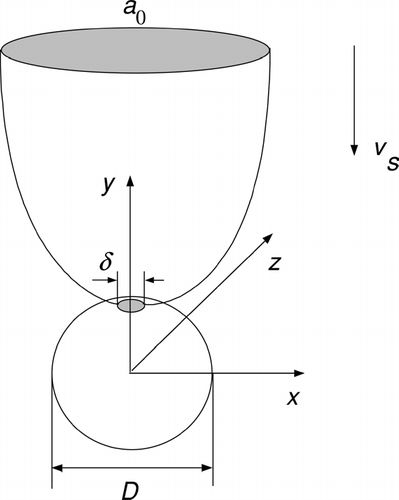
The aspiration efficiency A is defined as the ratio of the concentration c of particles passing through the sampler inlet to that, c0, in the undisturbed air far from the sampler. Using the continuity of particle fluxes inside the limiting particle trajectory surface we have
If the sampler is pointing vertically upwards then a0 is circular and is defined by its radius r1. However when the sampler is pointing vertically downwards the sampler body blocks the falling particles. In this case a0 is an annulus with inner radius r2 and hence can be written as:
Hence determining A reduces to calculating the limiting particle trajectories by solving the equations of particle motion in a given velocity field.
FLOW MODELS
The equations of steady motion governing the air motion in sampling situations are the Navier-Stokes equations for incompressible flow which, in their non-dimensional form, are given by
In the work described here we have used three types of fluid flow models to describe the air flow in the sampler vicinity.
Potential Flow Models
If Re is very large then the viscous forces are negligible and inertial forces dominate. In this case the flow may be assumed to be inviscid and such an assumption greatly simplifies the equations of motion. In this work it has been assumed that the flow is inviscid and two potential models have been developed:
| 1. | A point sink model where the finite orifice on the sphere is modelled as the sum of a number N of point sinks. The model is described in detail in CitationGaleev and Zaripov (2003). In the results shown here N = 91. | ||||
| 2. | A Boundary Element model where the flow velocities are obtained outside the sampler using the Boundary Element Method (BEM). The method in relation to calm air sampling problems has been described in detail in CitationDunnett and Wen (2002) and will not be repeated here. | ||||
For the sampling system considered Re is usually in the range O(102)–O(103) and although Re is large it is possible that within this range viscous effects become important. The inviscid case has been considered here in order to investigate its accuracy for modelling the sampling situation considered. A viscous flow model has also been adopted and results will be compared.
Viscous Flow Model
In this case a laminar flow model has been used to simulate the steady viscous flow for the spherical sampler. The control volume method and the SIMPLE algorithm (CitationPatankar 1980) were employed in order to solve the equations for the air motion. As for the previous potential model, this method in relation to calm air sampling has been described in detail in CitationDunnett and Wen (2002) and hence is not repeated here.
PARTICLE MOTION
Once the velocity of the air has been obtained analytically or numerically, it is possible to trace the paths of the particles in the flow field. Neglecting the influence of the particles on the air flow, due to their small size and low concentrations, and all forces except the aerodynamic drag force and gravity, we can write the equations of particle motion in non-dimensional form as follows:
In tracing the particle paths the particles were started at a very large distance from the sampler, where the flow was assumed to be undisturbed by the physical presence of the sampler. It was assumed that the particles were then moving with the same velocity as the airflow plus their settling velocity, vs, where
In the case when Rep < 1, a condition often met in experiments, this becomes
The particles were then traced and the limiting particle trajectories, i.e., those separating the particles which pass through the sampling inlet from those that do not, were determined. In obtaining the limiting trajectories, it was assumed that any particle which impacted the sampler surface adhered to it and hence the only ones to enter the sampler were those that passed directly across the sampling inlet.
RESULTS
Flow Velocity Results
Initially a comparison was made between the flow velocities obtained by the three flow models described. An example of the results is shown in for B = 10. In the velocity along the axis orthogonal to the symmetry axis is shown as a function of the non-dimensional distance away from the symmetry axis, L. In y′ takes the value 1.05. In the velocity along the symmetry axis is shown as a function of the non-dimensional position along the axis. Also shown in the figures are the velocities obtained by modelling the sampling inlet by a single sink. It can be seen that the single sink is a reasonable model except in the region in the vicinity of the sampling inlet. It can also be seen from the figures that the agreement between the potential and viscous models is good.
Figure 2 The distribution of the magnitude of the non-dimensional air velocity, V, for the value of the bluntness parameter B = 10, (a) on the axis orthogonal to the symmetry axis at y′ = 1.05. L is the non-dimensional distance from the symmetry axis. (Sampling inlet at y′ ≈ 0.995); (b) along the symmetry axis. BEM denotes results obtained by the Boundary Element Method.
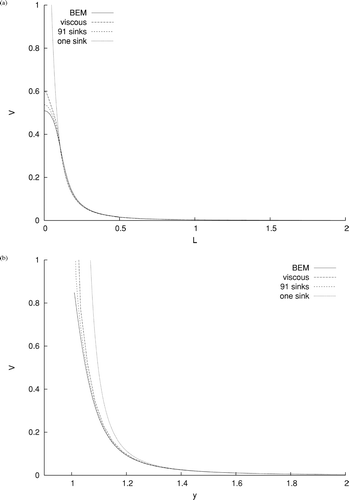
Sampler Pointing Upwards
Considering the case where the sampler faces vertically upwards numerical results have initially been obtained to compare with the experimental data of CitationSu and Vincent (2003). In the work of CitationSu and Vincent (2003), results are published for two values of the gravitational parameter RC, namely 0.1 and 0.01, for samplers such that B took values 5.3, 8, 10, and 15 and various values of the inertial parameter StC. In , A is shown as a function of StC for the two values of RC considered by CitationSu and Vincent (2003). For RC = 0.1 results are shown for all three flow models described. However for RC = 0.01 only the results from the BEM model and the viscous model are shown in the figure. This was done in order to make the figure clearer and because there was no discernable difference between the results obtained by the two potential models. As can be seen in all flow models give results that compare well with the experimental data. Although the numerical models do overestimate A in the majority of cases. The predictions of A obtained from the potential flow models, for the values of StC considered experimentally, lie within experimental error for 50% of the cases. For the viscous flow model this percentage is increased with all results obtained by the model for the values of StC considered experimentally, in the case of RC = 0.01, lying within the experimental error bars. In general the viscous results do lie below the potential model results hence in some cases bringing them closer to the experimental range. This is expected as the viscous model is a more accurate description of the flow field in the vicinity of the sampler. It can be seen from the figure that the potential models more accurately predict the experimental results for the smaller value of RC than they do for the larger values. For the range of conditions shown in a decrease in RC is caused by an increase in sampling velocity US. As US increases it is expected that the error in the flow velocities predicted by the potential models due to the neglect of viscosity will not be so significant. This is what is observed here in . Also comparing the results obtained by the potential model for the two values of RC considered, it can be seen that there is no significant difference in the results for the different values of B for RC = 0.1 but there is for RC = 0.01. In the case of RC = 0.01 the limiting particle trajectories have to move up around the sampler body in order to enter the sampling inlet, see , which is not the case for RC = 0.1, hence the bluntness of the sampler has more effect for the smaller RC.
Figure 3 Results for the sampler pointing upwards to compare with the experimental data of CitationSu and Vincent (2003). (a) Aspiration efficiency, A, as a function of Stokes number, StC, for values of the gravitational parameter RC = 0.1 and 0.01. BEM denotes results obtained by the Boundary Element Method. (b) limiting particle trajectories for Rc = 0.1 and Rc = 0.01 with bluntness parameter B = 5.3.
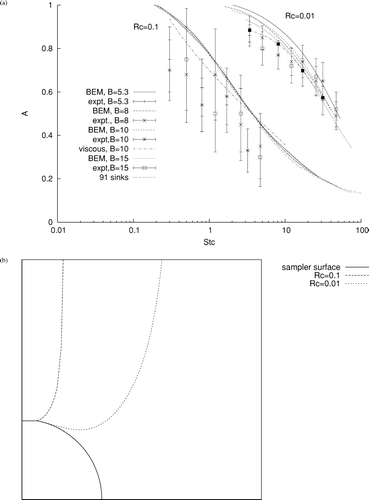
From we can see that although the viscous model is predicting the most accurate results, the potential models do predict values that are in reasonable agreement with the experimental data and the potential models are easier and less computationally expensive to obtain. Hence these models have been used to investigate the behaviour of A outside the range of values of RC considered experimentally. It was found that the effect of the bluntness of the sampler upon performance became more significant as RC decreased, though the effect was never great for parameter ranges corresponding to physically realistic situations. This is shown in where A is shown as a function of StC for RC = 0.2, 0.1, 0.01, and 0.001. The case of RC = 0.001 corresponds to large particle sizes and high sampling velocities and is unlikely to occur physically, however it does give us an indication of how sampler bluntness effects change as RC differs.
Figure 4 Aspiration efficiency, A, as a function of Stokes number, StC, for values of the gravitational parameter RC = 0.2, 0.1, 0.01, and 0.001 when the sampler is pointing upwards obtained numerically using the potential flow models.
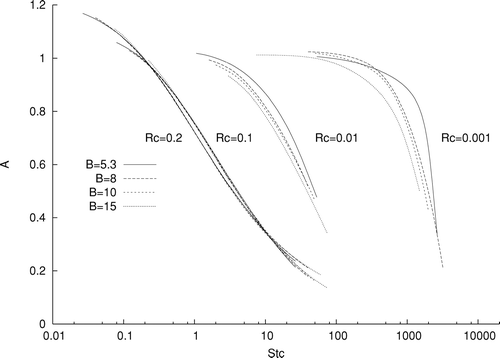
Over the years attempts have been made to develop semi-empirical models of the aspiration efficiency of samplers. In the case of calm air sampling such models have been restricted by the lack of experimental data with which to validate them CitationGrinshpun et al. (1993) explored a general equation for aspiration efficiency which could be applied to moving and calm air for a thin-walled sampler. In the case of calm air the model was restricted to a sampling orientation of 0 ≤ θ ≤ 90 where θ was the angle the sampler axis made with the vertical. As the model was developed for thin-walled samplers no account was taken for sampler bluntness. More recently, using their comprehensive experimental data, CitationSu and Vincent (2004a) developed empirical formulae for thin-walled and blunt samplers operating in calm air. In the case of a blunt sampler pointing upwards the formula for A is given by:
This formula was derived using CitationLevin's (1957) formula for a point sink model as a basis and hence is restricted to small values of the parameter k1.
When the sampling velocity, US, is very low, leading to small StC, particles may enter the sampling orifice directly by settling without help from the aspiration process. Hence in the limit StC → 0, A → 1 + RC. This behavior is independent of the shape of the sampler and hence will be true for thin-walled and blunt samplers. This has been noted previously by, for example, CitationYoshida et al. (1978) and CitationAgarwal and Liu (1980) and was also found to be the case in the numerical results obtained here.
The experimental results of CitationSu and Vincent (2003) do not appear to be tending to 1 + RC as StC becomes small, though if the error bars are taken into consideration it is possible. As noted by CitationSu and Vincent (2003) such experiments are very difficult, and it is possible that for low sampling velocities where any air movement will be very slight, such difficulties are increased. Expression (9), which was developed using the experimental data, has the property that A → 1 − RC 3/2(B1/2 − 1) as StC → 0. Hence expression (9) will be inaccurate for small StC and this inaccuracy will increase as RC increases. Also, in expression (9), B has a greater effect on A as RC increases. This is contrary to what has been observed here numerically.
An attempt has been made to modify Equation (Equation9) in order to obtain the correct limiting behavior at small StC. Using Equation (Equation9) as the starting point and altering it to obtain A = 1 + RC when StC = 0 expression (10) has been obtained.
As for Equation (Equation9), expression (10) is only valid for k1 < 1, hence restricting it to the ranges StC ≤ 8 for RC = 0.1 and StC ≤ 250 for RC = 0.01. The numerical results do not have these restrictions. Equation (Equation10) was found to model well the behavior of A for small k1, see where the expression is shown for RC = 0.1 and 0.01. Only one value of B is shown when displaying the numerical results in order to make the figure clearer. It is found that agreement with the numerical results deteriorates as RC decreases.
Figure 5 Aspiration efficiency, A, as a function of Stokes number, StC, for values of the bluntness parameter B = 15, RC = 0.1, and 0.01 when the sampler is pointing upwards, obtained numerically and given by the empirical expression (10).
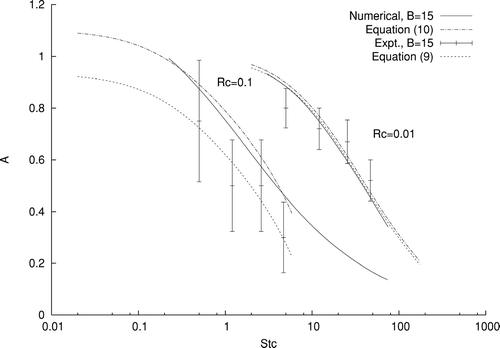
Although, as shown earlier, A does depend upon B for small RC it was not found possible to model well this dependence in Equation (Equation10) using the method adopted here. As Equation (Equation10) was obtained by adapting Equation (Equation9) and this was derived from a point sink model, both equations are limited in modelling this dependence upon sampler bluntness. In order to do this it may be necessary to start from a different basis, not the point sink model used by Su and Vincent. It is believed however that Equation (Equation10) is a good estimate for the larger values of RC considered experimentally but it cannot model the B dependence found at smaller RC.
Sampler Pointing Downwards
Considering the case when the sampler is pointing vertically downwards. Numerical results have been obtained to compare with the experimental data of Su and Vincent (Citation2003, Citation2004b) In results are shown for RC = 0.01 for B = 5.3 and 8. The other values of B considered to compare with the experimental data, namely, B = 10 and 15, were found to give A = 0 for all values of StC considered. This is due to the fact that for these larger values of B, particles were either collected on the top of the sampler or passed directly by the sampler, none were actually collected through the sampling inlet. This was also found to be the case experimentally by CitationSu and Vincent (2003). As can be seen in the figure all the numerical models predict results which are close to the experimental data. In the case of the potential flow models the results obtained lie within the scatter of the experimental points as shown by their error bars, except for one point. For the viscous flow model all results lie within the experimental error bars. The viscous model does in general, however, predict results which are slightly lower than those predicted by the potential models, especially for B = 8. In results are shown for B = 5.3 for RC = 0.01, 0.02, and 0.025. As can be seen the potential models predict the experimental results well for RC = 0.01 but increasingly overpredict the experimental results as RC increases. This is also the case for the viscous model, where the results for RC = 0.01 agree very well with the experimental data but for RC = 0.025 the results are close to the predictions made by the potential models but well above the experimental data. It is unclear why there is such disagreement between the numerical and experimental results for RC = 0.025. However all three numerical models are in agreement with each other. For this value of RC conditions are such that the sampling velocities are low and hence air movement minimal making the experiments more difficult. Also, as RC increases, the measurement of the area enclosed by the limiting particle trajectories is complicated by the fact that the radius of the outer area, r1, approaches that of the inner area, r2. More experimental data is necessary to fully understand sampler performance in this parameter range.
Figure 6 Results for the sampler pointing downwards to compare with the experimental data of Su and Vincent (Citation2003, Citation2004). (a) Aspiration efficiency, A, as a function of Stokes number, StC, for values of the bluntness parameter B = 8 and 5.3, when the gravitational parameter RC takes the value 0.01. (b) Aspiration efficiency, A, as a function of Stokes number, StC, for values of the gravitational parameter RC = 0.01, 0.02, and 0.025, when the bluntness parameter B takes the value 5.3. BEM denotes results obtained by the Boundary Element Method.
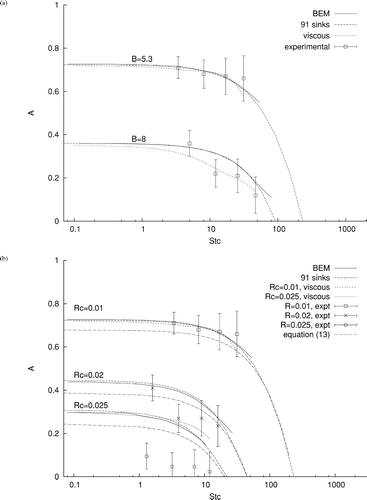
Considering the limiting situation of small StC when the inertia of the particles can be neglected, it can be shown, see appendix, that no particles will be sampled if B2RC > 1. If B2RC < 1, and hence particles are sampled, then as StC → 0 A → 1 − B2RC. This explains why A was found to be zero for RC = 0.01, B = 10 and 15 as discussed earlier. For all cases shown in the numerical results tend towards the predicted value of 1 − B2RC as StC → 0.
CitationFrom Su and Vincent (2003), the reduction in A due to the effect of the blunt sampler body can be expressed as:
Hence the difference in A between a sampler with bluntness parameter B = B1 and one with bluntness parameter B = B2 is given by
Therefore the difference between the samplers with values of the bluntness parameter of B = 8 and 5.3 when RC = 0.01 is approximately 0.36. The numerical results shown in agree with this prediction.
The empirical formula developed by CitationSu and Vincent (2004b) for a blunt sampler pointing downwards is given by:
As StC → 0 in this expression A → 1 − 0.5RC 1/2 − RC (B2 − 1) and not 1 − B2RC as required. Modifying equation (Equation13) to obtain the required limit as StC → 0 the following expression was obtained.
In , Equations (13) and (14) are plotted alongside the numerical results, both potential and viscous flow model results, for B = 5.3, RC = 0.01, 0.02, and 0.025. As can be seen agreement is good between the numerical results and the empirical formula. The agreement does decrease for larger values of StC but this is expected as the formula is only valid for small k1 corresponding to small StC. Similar agreement was found for all results obtained. Agreement is also good between the experimental results and the empirical formula (14) except for RC = 0.025, where disagreement between experimental and numerical results, and also the earlier empirical formula (13), exists as discussed earlier.
Figure 7 Aspiration efficiency, A, as a function of Stokes number, StC, for values of the gravitational parameter RC = 0.01, 0.02, and 0.025 when the bluntness parameter B takes the value 5.3 and the sampler is pointing downwards. Results obtained numerically and experimentally are compared with the 2 empirical expressions (13) and (14). BEM denotes results obtained by the Boundary Element Method.
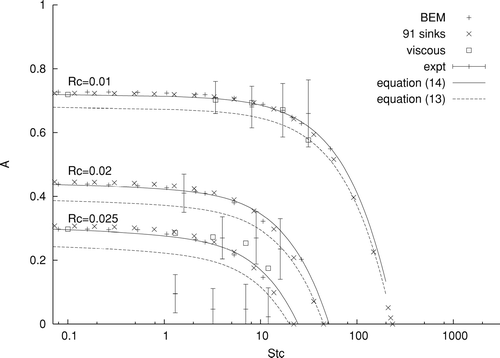
The case of B = 1 corresponds to a thin-walled tube sampler, hence expression (14) has been plotted alongside available numerical and experimental data for this case, in . As can be seen agreement is good between the predictions given by Equation (Equation14) and the past work, in particular when comparing with CitationYoshida et al's (1978) available experimental and numerical data for RC = 0.05.
Figure 8 Aspiration efficiency, A, as a function of Stokes number, StC, for values of the gravitational parameter RC = 0.1, 0.05, and 0.01 when the bluntness parameter B takes the value 1 and the sampler is pointing downwards. Results obtained numerically and experimentally are compared with the 2 empirical expressions (13) and (14).
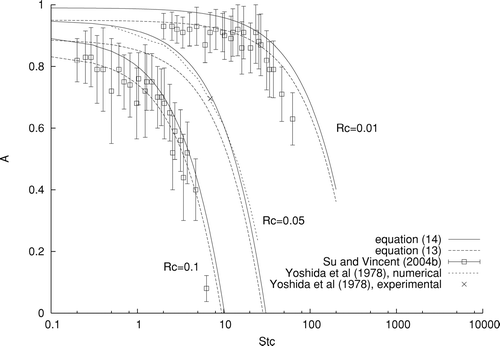
Numerical calculations were also performed for large values of the parameter B, corresponding to a small sampling orifice relative to the sampler diameter. In these cases it was observed that as well as particle deposition on the sampler head due to gravitational settling, inertial impaction of particles near the suction orifice also occurred. The relative size of the sampling orifice necessary for this effect to be observed was outside the range of values generally taken by real samplers and hence the numerical results have not been shown in this paper.
CONCLUSIONS
From the models developed here, for the case of the sampler oriented with its inlet facing upwards, it is found from the aspiration results and the particle behaviour near the sampler that the bluntness of the sampler has a greater effect upon sampler performance for smaller values of the relative particle settling velocity, RC. Though for all physically realistic values of RC the differences in the predicted values of A for different values of B are always small. This is not the case for downwards sampling where the bluntness of the sampler has a bigger effect upon sampler performance. It has been shown here that no aspiration will take place, in this case, if the value of the expression B2RC is greater than unity. It has also been shown that for small values of the Stokes number, StC, the aspiration efficiency can be approximated by 1 − B2RC. A discrepancy was found between the numerical and experimental results for conditions corresponding to low sampling velocities. The numerical results do follow the expected trends and the different numerical models are in agreement. Therefore more experimental data in this region is necessary to understand why this difference occurs and hence better understand sampler performance.
The limiting behavior of A obtained from physical considerations has been used to extend the empirical formulae developed previously for upwards and downwards facing samplers. However these formulae are restricted to a limited range of the parameter involved, a restriction not imposed by the numerical models described here.
Appendix
Limiting case as StC → 0 for sampler pointing downwards.
Imagine a large sphere, diameter α here α ≫ D, surrounding the sampler. When the sampling rate is Q the number of particles entering this sphere per unit time is
Hence
Sampling commences when s = 0 ⇒ πD2vs = 4Q = π δ2Us
Therefore c > 0, and hence A > 0, for B2RC < 1, s = 0. In this case
This is for the limiting case of StC → 0 and hence in the results obtained in this work we would expect that A = 0 for B2RC > 1 and for situations where B2RC < 1 as StC → 0 A → 1 − B2RC.
REFERENCES
- Agarwal , J. K. and Liu , B. Y. H. 1980 . A Criterion for Accurate Aerosol Sampling in Calm Air . Am. Ind. Hyg. Assoc. J. , 41 : 191 – 197 . [INFOTRIEVE] [CSA]
- Baldwin , P. E. J. and Maynurd , A. O. 1998 . A Survey of Wind Speeds in Indor Workplaces . Ann. Occup. Hyg. , 20 : 303 – 313 . [CSA] [CROSSREF]
- Belyaev , S. P. and Kustov , V. T. 1980 . Sampling from Calm Air . Trudy IEM , 25 : 102 – 108 . (in Russian)[CSA]
- Chung , I. P. and Dunn-Rankin , D. 1993 . The Effects of Bluntness and Orientation on Two-Dimensional Samplers in Calm Air . Aerosol Sci. Technol. , 19 : 371 – 380 . [CSA]
- Davies , C. N. and Peetz , V. 1954 . Dust Shadows Below a Cylinder Containing a Suction Orifice and Deposition of Particles upon the Cylinder . Brit. J. Appl. Phy. , S3 : S17 – 20 . [CSA] [CROSSREF]
- Dunnett , S. J. 2002 . Particle Motion in the Vicinity of a Bulky Sampling Head Operating in Calm Air . Aerosol Sci. Technol. , 36 : 308 – 317 . [CSA] [CROSSREF]
- Dunnett , S. J. and Wen , X. 2002 . A Numerical Study of the Sampling Efficiency of a Tube Sampler Operating in Calm Air Facing Both Vertically Upwards and Downwards . J. Aerosol Sci. , 33 : 1653 – 1665 . [CSA] [CROSSREF]
- Galeev , R. S. and Zaripov , S. K. 2003 . Theoretical Study of Aerosol Sampling by an Idealised Spherical Sampler in Calm Air . J. Aerosol Sci. , 34 : 1135 – 1150 . [CSA] [CROSSREF]
- Grinshpun , S. A. , Lipatov , G. N. and Semonyuk , T. I. 1989 . A Study of Sampling of Aerosol Particles from Calm Air into Thin-Walled Cylindrical Probes . J. Aerosol Sci. , 20 : 1561 – 1564 . [CSA] [CROSSREF]
- Grinshpun , S. A. , Willeke , K. and Kalatoor , S. 1993 . A General Equation for Aerosol Aspiration by Thin-Walled Sampling Probes in Calm and Moving Air . Atmos. Environ. , 27 : 1459 – 1470 . [CSA]
- Kaslow , D. E. and Emrich , R. J. 1973 . Aspirating Flow Pattern and Particle Inertia Effects Near a Blunt Thick-Walled Tube Entrance, Technical Report 23 , PA, USA : Department of Physics, Lehigh Univerisity .
- Kaslow , D. E. and Emrich , R. J. 1974 . Particle Sampling Efficiencies for an Aspirating Blunt Thick-Walled Tube in calm air, Technical report 25 , PA, USA : Department of Physics, Lehigh Univerisity .
- Levin , L. M. 1957 . The Intake of Aerosol Samples . Izvestiya Akademi Naik SSSR Seriya Geofizika. , 7 : 914 – 925 . [CSA]
- Liu , B. Y. H. , Zhang , Z. Q. and Kuehn , T. H. 1989 . A Numerical Study of Inertial Errors in Anisokinetic Sampling . J. Aerosol Sci , 20 : 367 – 380 . [CSA] [CROSSREF]
- Patankar , S. V. 1980 . Numerical Heat Transfer and Fluid Flow, Series in Computational Methods in Mechanics and Thermal Sciences Hemisphere, NY
- Su , W. C. and Vincent , J. H. 2002 . New Experimental Method to Directly Measure Aspiration Efficiencies of Aerosol Samplers in Calm Air . J. Aerosol Sci. , 33 : 103 – 118 . [CSA] [CROSSREF]
- Su , W. C. and Vincent , J. H. 2003 . Experimental Measurements of Aspiration Efficiency for Idealized Spherical Aerosol Samplers in Calm Air . J. Aerosol Sci. , 34 : 1151 – 1165 . [CSA] [CROSSREF]
- Su , W. C. and Vincent , J. H. 2004a . Experimental Measurements and Numerical Calculations of Aspiration Efficiency for Cylindrical Thin-Walled Aerosol Samplers in Perfectly Calm Air . Aerosol Sci. Tech. , 38 : 766 – 781 . [CSA] [CROSSREF]
- Su , W. C. and Vincent , J. H. 2004b . Towards a General Semi-Empirical Model for the Aspiration Efficiencies of Aerosol Samplers in Perfectly Calm Air . J. Aerosol Sci. , 35 : 1119 – 1134 . [CSA] [CROSSREF]
- Vincent , J. H. 1989 . Aerosol Sampling: Science and Practice , Chichester, , UK : John Wiley and Sons .
- Yoshida , H. , Uragami , M. , Hasuda , H. and Iinoya , K. 1978 . Particle Sampling Efficiency in Still Air . Kagaku Kogaku Ronbunshu. , 4 : 123 – 128 . (English translation by the United Kingdom Health and Safety Executive (HSE) translation N 8586)[CSA]
